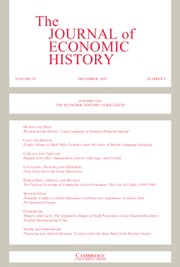Crossref Citations
This article has been cited by the following publications. This list is generated based on data provided by
Crossref.
Lehmann-Hasemeyer, Sibylle
Hauber, Philipp
and
Opitz, Alexander
2014.
The Political Stock Market in the German Kaiserreich — Do Markets Punish the Extension of the Suffrage to the Benefit of the Working Class? Evidence from Saxony.
The Journal of Economic History,
Vol. 74,
Issue. 04,
p.
1140.
Guo, Di
Jiang, Kun
Kim, Byung-Yeon
and
Xu, Chenggang
2014.
Political economy of private firms in China.
Journal of Comparative Economics,
Vol. 42,
Issue. 2,
p.
286.
Fohlin, Caroline
2014.
Financial Systems and Economic Development in Historical Perspective.
SSRN Electronic Journal,
Hale, Matthew
Raymond, Graham
and
Wright, Catherine
2014.
List of publications on the economic and social history ofGreatBritain and Ireland published in 2013.
The Economic History Review,
Vol. 67,
Issue. 4,
p.
1113.
Burhop, Carsten
Chambers, David
and
Cheffins, Brian
2014.
Regulating IPOs: Evidence from going public in London, 1900–1913.
Explorations in Economic History,
Vol. 51,
Issue. ,
p.
60.
Fohlin, Caroline
2014.
Handbook of Cliometrics.
p.
1.
Kogan, Theodore Benjamin
and
Salganik-Shoshan, Galla
2015.
Corporate governments: Government connections of public oil and gas companies.
Corporate Ownership and Control,
Vol. 12,
Issue. 4,
p.
286.
Costen, Michael
Slavin, Philip
Paul, Helen
Walsh, Patrick
Crook, Tom
Velkar, Aashish
and
Godden, Christopher
2015.
Review of periodical literature published in 2013.
The Economic History Review,
Vol. 68,
Issue. 1,
p.
286.
Acheson, Graeme G.
Campbell, Gareth
and
Turner, John D.
2015.
Active Controllers or Wealthy Rentiers? Large Shareholders in Victorian Public Companies.
Business History Review,
Vol. 89,
Issue. 4,
p.
661.
Braggion, Fabio
Dwarkasing, Narly
and
Moore, Lyndon
2015.
Nothing Special About Banks: Competition and Bank Lending in Britain, 1885-1925.
SSRN Electronic Journal,
Grossman, Richard S.
and
Imai, Masami
2016.
Taking the lord's name in vain: The impact of connected directors on 19th century British banks.
Explorations in Economic History,
Vol. 59,
Issue. ,
p.
75.
Acheson, Graeme G.
Coyle, Christopher
and
Turner, John D.
2016.
Happy hour followed by hangover: financing the UK brewery industry, 1880–1913.
Business History,
Vol. 58,
Issue. 5,
p.
725.
Amini, Shima
Lei, Lei
and
Toms, Steve
2016.
Accessing Capital Markets: Aristocrats and New Share Issues in the Cycle and Pneumatic Tyre Industries, 1892-1898.
SSRN Electronic Journal,
Szakonyi, David
2016.
Businesspeople in Elected Office: Identifying Private Benefits from Firm-Level Returns.
SSRN Electronic Journal ,
Fohlin, Caroline
2016.
Handbook of Cliometrics.
p.
393.
Kam, Christopher
2017.
The Secret Ballot and the Market for Votes at 19th-Century British Elections.
Comparative Political Studies,
Vol. 50,
Issue. 5,
p.
594.
van Hombeeck, Carlos
2017.
An Exorbitant Privilege in the First Age of International Financial Integration.
SSRN Electronic Journal ,
Horiuchi, Yusaku
Kage, Rieko
and
Katsumata, Hiroto
2017.
Searching for Contributions by Moonlight: Politically Connected Firms in Japan.
SSRN Electronic Journal ,
Okazaki, Tetsuji
and
Sawada, Michiru
2017.
Measuring the extent and implications of corporate political connections in prewar Japan.
Explorations in Economic History,
Vol. 65,
Issue. ,
p.
17.
Braggion, Fabio
Dwarkasing, Narly
and
Moore, Lyndon
2017.
Nothing Special About Banks: Competition and Bank Lending in Britain, 1885–1925.
The Review of Financial Studies,
Vol. 30,
Issue. 10,
p.
3502.


